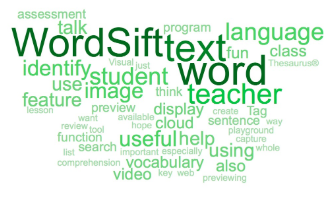
Sifting Key Words

Overview
Wordsift is a free online tool where teachers and/or students copy text and put relevant vocabulary words into a word cloud. Unlike WordClouds.com OR TAGXEDO, where ALL the words are put into a cloud, Wordsift “sifts” through the text and looks at more important academic vocabulary and creates word clouds with the key vocabulary. It can also highlight words for various content areas.
It also provides a Cloud view or text view and allows you to mark specific words of importance.
This is a great tool for all students, but could be very beneficial to any student who needs assistance.
Learning Objectives
Students will:
- Be able to use WORDSIFT to find KEY vocabulary words in a given text.
- Be able to use WORDSIFT to explore Dr. Martin Luther King’s “I Have a Dream” Speech. (For beginners and for this lesson)
Vocabulary
Vocabulary Words:
-
Academic Vocabulary: Academic Vocabulary is defined as words that are traditionally used in academic dialogue and text. Specifically, it refers to words that are not necessarily common or frequently encountered in informal conversation.
-
Word Cloud: A word cloud is a graphical representation of word frequency.
Pre-planning
To prepare for this lesson:
- Learn how to use Wordsift.
- Watch the Secrets of Wordsift video.
- If using it for lessons, watch the video on how to do a screen capture and embed the Cloud into a document.
- Try it yourself!
- Go to https://wordsift.org.
- Choose the example of Martin Luther King’s “I Have A Dream Speech” on the website. (The examples could change so be prepared to give the text to the students.)
- Explore the tools that you can use with your students.
Accommodations
See the Accommodations Page and Charts on the 21things4students website in the Teacher Resources.
Steps
Directions for this activity:
-
Say to the students, “Today we are going to find some important key vocabulary by using a new tool called Wordsift, to break down Martin Luther King’s “I Have A Dream Speech”. We are going to look at key vocabulary words. Listen to the speech.
-
Ask students what did they learn?
-
They may not have too many concepts to add at this point. Then say, “Okay, now this can be tricky, but I have a tool that will help us.”
-
Show the video Secrets of Wordsift.
-
Many students may think that it looks like ABCYA's WORD CLOUDS or TAGXEDO. Let them know that this is better because it “sifts” or pull out the important keywords that will help us to understand the text better.
-
Have the students try it.
-
Go to https://wordsift.org.
-
The students will click on Martin Luther King’s “I Have A Dream Speech”. (If this is no longer available choose another example listed or give the students the text to paste into the box.)
-
Explore the tools that you can use with your students.
-
Show them how they can create a word cloud.
-
Ask students, “Do you see any other words that maybe you did not hear or notice before?” Have a conversation and pull out that essential vocabulary.
-
Demonstrate how to click on SORT and MARK words. Have them click on TEXT, then MARK WORDS AND highlight academic words. Go over what these words mean. Listen to the speech again.
-
Show students that they can use this tool for any online text. They simply need to copy and paste text into Wordsift.
-
If time permits, let them explore.
Note: Here are shortcuts to use when copying and pasting the text into Wordsift.
iOS Shortcuts: COPY: Command+C PASTE: Command+V
PC Shortcuts: COPY: Control+C PASTE: Control+V
Assessment Options
Different options for assessing the students:
- Observations
- Check for understanding
MITECS COMPETENCIES & ISTE STANDARDS
MITECS: Michigan adopted the "ISTE Standards for Students" called MITECS (Michigan Integrated Technology Competencies for Students) in 2018.
Knowledge Constructor
3a. Students plan and employ effective research strategies to locate information and other resources for their intellectual or creative pursuits.
3b. Students evaluate the accuracy, perspective, credibility and relevance of information, media, data or other resources.
3c. Students curate information from digital resources using a variety of tools and methods to create collections of artifacts that demonstrate meaningful connections or conclusions.
3d. Students build knowledge by actively exploring real-world issues and problems, developing ideas and theories and pursuing answers and solutions.
Devices and Resources
Device: PC, Chromebook, Mac, iPad
Browser: Chrome, Safari, Firefox, Edge, ALL
App, Extension, or Add-on:
Websites:
CONTENT AREA RESOURCES
ELA
Copy and paste a piece of non-fiction text into Wordsift. Pull out the academic vocabulary.
Math
Copy and paste some mathematical terms into Wordsift. Do these words have anything in common?
Science
Copy an article on animal adaptations and pull out the science words. Define those words and re-read the passage to check for understanding.
Social Studies
Copy another famous speech or facts from an online Social Studies book. Define the key words and create a Cloud of the key vocabulary words.
Credits
This task card was created by Courtney Conley, Utica Schools, January 2019. Updated October 2023.


